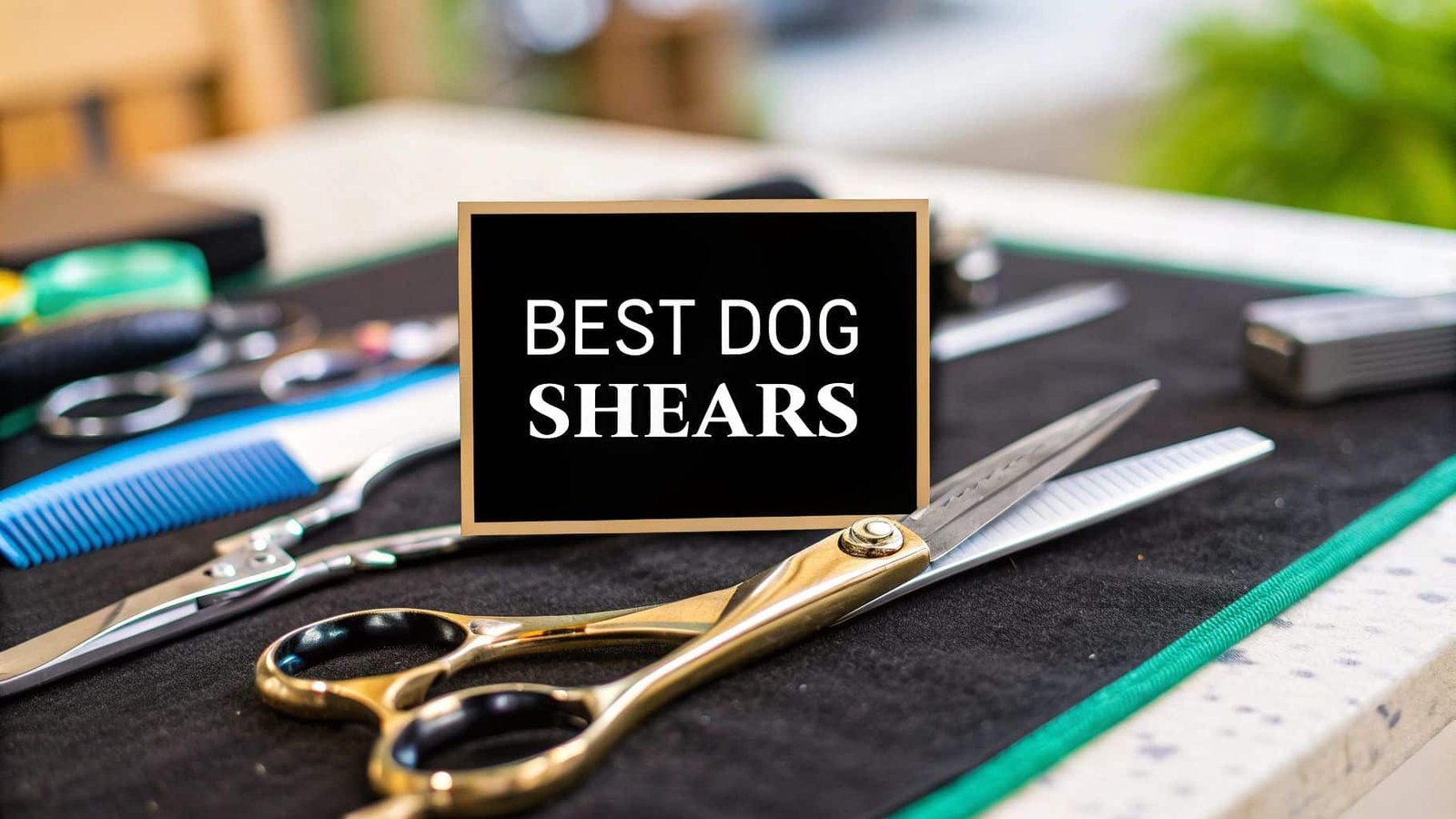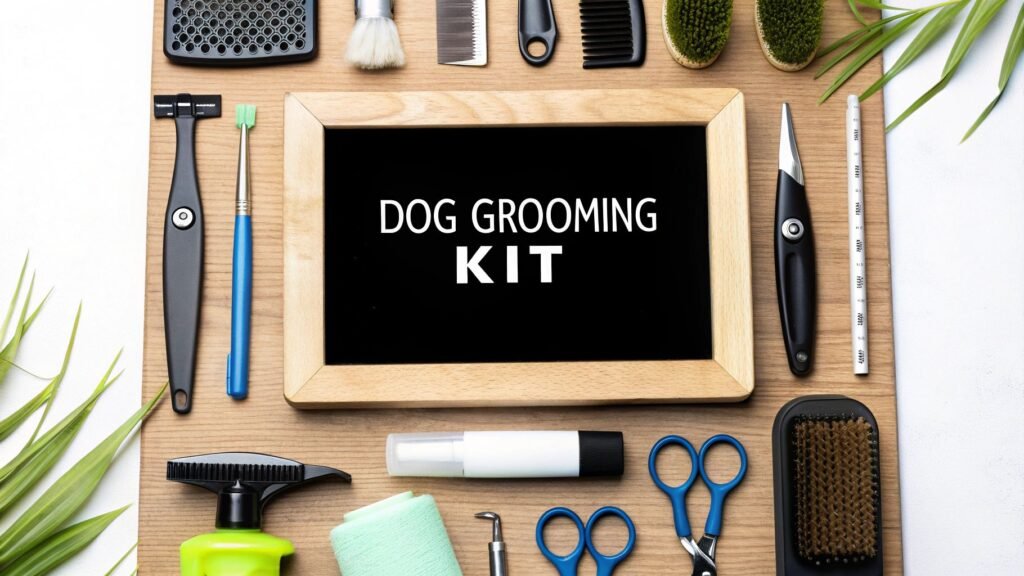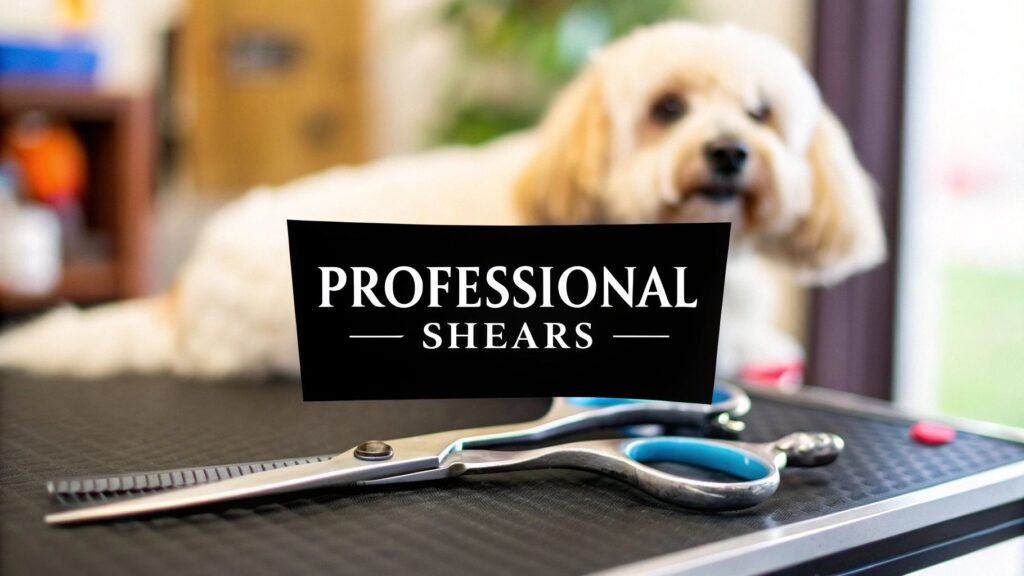Top Picks for Best Dog Grooming Shears | Expert Guide

For groomers at home, the best dog grooming shears aren’t a single pair but a versatile kit. You’ll want a set that includes straight, curved, and thinning shears, ideally crafted from a durable material like Japanese 440C stainless steel. This trio gives you everything you need for the whole job, from trimming bulk fur to the delicate finishing touches, helping you get that professional look safely and efficiently.
Choosing Shears for a Perfect At-Home Groom
Picking out the right dog grooming shears can feel like a huge task, but having the right tools is absolutely critical for your dog’s comfort and getting a clean, quality cut. This guide is here to cut through the noise and help you choose with confidence. The perfect set of shears doesn’t just make the groom look better—it makes the entire process safer and calmer for both of you as per our review of top brushes

It’s no surprise that the market for these tools is booming. Valued at roughly USD 275 million in 2023, the global pet grooming shears market is projected to hit nearly USD 450 million by 2032. This jump shows just how many pet owners are deciding to invest in quality tools for grooming at home. You can dig deeper into the latest pet grooming market trends for more details.
Key Factors for Selecting Shears
To make a smart choice, you really only need to focus on three things that make the difference between a decent pair of shears and a great one. Getting a handle on these elements is your first step to building a grooming kit you can rely on.
- Shear Type: Different shears are built for different jobs. Straight shears are your workhorse for clean, straight lines. Curved shears are for shaping contours like paws and heads. Thinning shears are essential for blending and softening the final look.
- Blade Material and Edge: The quality of the steel—like the popular Japanese 440C—is a huge factor in how sharp the blade stays and how long it lasts. The edge type, whether it’s convex or serrated, will also change how the shear cuts through fur.
- Handle Ergonomics: How the handle is designed (think offset, crane, or level sets) directly affects your comfort and control. A good ergonomic fit can drastically reduce hand fatigue, especially during those longer grooming sessions.
When you match the right tool to your dog’s coat and what you’re trying to achieve, you can really take your home grooming to the next level. Think of this guide as your roadmap to navigating the options.
Key Insight: The biggest mistake I see beginners make is trying to do everything with one all-purpose shear. A simple kit with a straight, a curved, and a thinning shear gives you the versatility you need for a complete, beautifully blended groom.
At-a-Glance Guide to Grooming Shear Types
To help you get started, here’s a quick cheat sheet that breaks down the main purpose of each type of shear.
| Shear Type | Primary Use | Best For Coat Types |
|---|---|---|
| Straight Shears | General trimming and creating straight lines | Drop coats (Yorkie), curly coats (Poodle) |
| Curved Shears | Shaping and contouring rounded areas (paws, face) | Poodles, Bichons, and for topknots |
| Thinning Shears | Blending, softening harsh lines, removing bulk | Double coats (Golden Retriever), thick coats |
This table should give you a solid foundation for understanding which tool to reach for and when.
Comparing Straight, Curved, and Thinning Shears
The first step to building a truly professional grooming kit is understanding that each type of shear has a very specific job. It’s not enough to just know their names; the real art of grooming comes from knowing exactly when and why to pick up a certain pair. Let’s move past the basics and dig into what each tool is really designed for, so you can make the right call every time.

This breakdown will give you the practical know-how to grab the perfect shear for any situation you’ll face on the grooming table.
The Workhorse: Straight Shears
Think of straight shears as the foundation of any great groom. Their main purpose is straightforward: cut clean, crisp lines and efficiently remove bulk hair. They are absolutely essential for setting the basic length and shape of the coat, especially on the larger, flatter areas of a dog’s body like the back and sides.
For instance, if you’re working on a drop coat like a Yorkshire Terrier or a Shih Tzu, straight shears are what you’ll use to get that classic, smooth finish along the body. For any task that demands a perfectly straight edge, these are your go-to.
The Artist’s Tool: Curved Shears
If straight shears build the structure, curved shears add the artistry. Their blades are specifically shaped to follow the natural lines and contours of a dog’s body, which makes them the perfect tool for shaping and rounding.
These are a must-have for breeds like Poodles or Bichon Frises, where rounded topknots, feet, and tails are part of the signature look. They’re also a lot safer and more effective for trimming around sensitive areas like paws, faces, and sanitary regions, since the curve helps prevent you from accidentally poking the dog.
Situational Tip: Always reach for curved shears when working on the “tuck up” area near a dog’s rear legs. Trying to use a straight shear here is awkward and risky. A curved blade, on the other hand, follows the body’s lines perfectly, giving you a smooth, natural-looking transition.
The Blending Experts: Thinning and Chunking Shears
Finally, we get to the shears that can hide almost any mistake and create that flawless, natural-looking finish. Both thinning and chunking shears remove hair, but they do it in very different ways and for very different reasons.
- Thinning Shears: These have very fine teeth on one blade and a solid cutting blade on the other. They’re designed to remove just a tiny bit of hair with each snip. This makes them ideal for softening any harsh lines left by your other shears and blending away any “choppy” looking spots. They’re also great for thinning out minor bulk in thick fur without taking away any of the length.
- Chunking Shears (or Blenders): These shears have wider teeth, so they take out more hair with each cut than regular thinners. They are fantastic for adding texture and removing serious bulk from really dense coats—think of a Golden Retriever’s thick feathering. They do this while still leaving a more natural, less blunt finish than you’d get with a straight shear.
Choosing the best dog grooming shears is all about having the right tool for each distinct part of the job. Once you understand these functional differences, you can build a kit that sets you up for success and ensures every groom is precise and polished. To see a full range of professional-grade tools, you can explore a wide selection of grooming and cleaning supplies designed for every breed and coat imaginable.
A Closer Look at Blade Materials and Cutting Edges
The real magic of any great shear is in the blade. What separates a smooth, professional-looking cut from a choppy, frustrating mess comes down to the metal and how it’s sharpened. This is where the true craftsmanship behind the best dog grooming shears really shines.
The steel used determines everything—how sharp the blade gets, how long it stays that way, and how well it resists rust and nicks. “High-performance steel” isn’t just a fancy label; it means you’re getting a reliable tool that can handle countless grooming sessions without losing its edge. It’s why seasoned groomers are willing to invest in shears made from top-tier alloys.
Japanese vs. German Stainless Steel
When it comes to blade materials, two major players dominate the field: Japanese and German stainless steel. Japanese 440C stainless steel is renowned for its incredible hardness. This quality allows it to be honed to an exquisitely fine, razor-sharp edge, perfect for delivering those crisp, clean lines needed for finishing work.
On the other hand, German stainless steel is the undisputed workhorse. It’s prized for its sheer durability and toughness. While it might not hold the same super-fine edge as Japanese steel, it’s incredibly resistant to chipping and damage, making it a fantastic choice for everyday, all-purpose grooming, especially on thicker or more challenging coats.
Expert Insight: For achieving that flawless, show-ring finish on a fine-coated breed like a Maltese, Japanese steel is second to none. But for the demanding, day-in-day-out work of a busy salon or for powering through a dense double coat like a Bernese Mountain Dog’s, the resilience of German steel is a huge plus.
This infographic highlights the key things to weigh when you’re choosing, from the materials to the handle design and price.

As you can see, better materials usually mean a more ergonomic design and a higher price tag, but the trade-off is superior performance and a tool that will last for years.
You’ll also find shears with cobalt or titanium coatings. These aren’t just for adding a splash of color—they’re bonded to the steel to make the surface harder and reduce drag. A titanium coating, for example, helps the blade glide through fur with less effort and can dramatically extend the life of the cutting edge.
To help you sort through the options, here’s a quick breakdown of how these materials and edge types stack up.
Blade Material and Edge Performance Breakdown
| Feature | Japanese 440C Steel (Convex Edge) | German Steel (Serrated Edge) | Titanium Coated (Convex Edge) |
|---|---|---|---|
| Best For | Finishing, precision scissoring, fine coats | Bulk trimming, coarse or wiry coats, beginners | All-purpose use, stylists wanting extra durability |
| Cut Feel | Silky smooth, effortless glide | Grips hair, prevents slipping | Very smooth with reduced friction |
| Durability | Holds edge well but can be brittle | Extremely tough, resists nicks and drops | Enhanced hardness, resists wear and corrosion |
| Maintenance | Requires professional sharpening | More forgiving, can be sharpened multiple times | Edge lasts longer, needs professional care |
| Common Breeds | Poodles, Bichons, Shih Tzus | Terriers, Doodles, double-coated breeds | Versatile for most coat types |
Ultimately, the right material comes down to the specific jobs you’ll be doing most often.
Convex vs. Micro-Serrated Edges
The blade’s edge is just as critical as the steel it’s made from. You’ll mainly run into two types: convex and micro-serrated.
- Convex Edge: Also called a Japanese-style or clamshell edge, this blade is ground to an incredibly sharp, fine angle. This design delivers a buttery-smooth cut, making it the top choice for precision styling where you don’t want any scissor marks left behind.
- Micro-Serrated Edge: On these shears, one or both blades feature tiny, almost invisible teeth that grip the hair as you close the blades. This is a game-changer for preventing slippery fur from pushing away, which is especially helpful for bulk trimming or working on wiry coats.
The demand for these specialized tools is growing fast. The pet grooming scissors market was valued at USD 120 million in 2024 and is expected to climb to USD 180 million by 2033, fueled by a thriving pet care industry. You can learn more about the growth of the pet grooming market. By understanding the nuances of different materials and edges, you’re not just buying a tool—you’re investing in one that’s perfectly suited to your needs.
Why Ergonomics and Handle Design Really Matter
When we talk about shears, everyone focuses on the blades. But let me tell you, after a few hours of grooming, it’s the handle design that you’ll either be thanking or cursing. A great cut is all about control and comfort, which is why the handle is just as crucial as the steel.
The best dog grooming shears should feel like they were made for your hand, giving you the precision you need without leaving you with aches and pains. This is where ergonomics isn’t just a buzzword; it’s a critical factor that can make or break your grooming experience.
Think about it: long grooming sessions with clunky, poorly designed shears can lead to serious repetitive stress injuries like carpal tunnel syndrome. A well-designed, ergonomic handle encourages a more relaxed, open hand position, which goes a long way in protecting your joints over the years.
A Breakdown of Handle Styles
You’ll generally run into three main handle designs, and each one offers a totally different feel and level of support. Getting to know them is the first step to finding your perfect match.
- Opposing (Level) Handles: This is the classic, no-frills design you’ve probably seen a thousand times, with both finger rings perfectly aligned. They work for a quick snip here and there, but this symmetrical style forces your thumb into an awkward position, creating a lot of tension in your hand and wrist. You’ll typically find these on more budget-friendly shears.
- Offset Handles: Now we’re talking. Offset handles are a major upgrade in comfort, featuring a shorter thumb handle that lets your hand stay in a more open, natural position. This small change makes a huge difference in reducing strain on your thumb tendon. It’s a fantastic middle-ground and a popular choice for home groomers and pros alike.
- Crane Handles: For the serious groomer, this is the gold standard. Crane handles have a dramatically angled thumb ring that lets you drop your elbow and shoulder into a much more relaxed posture. It’s a game-changer for minimizing stress on your entire arm, which is why so many professionals swear by them for those long, back-to-back grooming days.
My Two Cents: If you plan on grooming for more than 30 minutes at a stretch, do yourself a favor and invest in at least an offset handle. The difference in hand fatigue is night and day. Not only will you feel better, but your improved precision will result in a safer, cleaner cut for the dog.
The Little Details That Make a Big Difference
Beyond the main handle shape, a few smaller features can really fine-tune your control and take a pair of shears from good to great. Look for an adjustable tension system, which is usually a screw or dial right at the pivot point. This lets you dial in the blade resistance to your exact liking for a buttery-smooth cutting motion that won’t wear out your hand.
Another must-have is a finger rest. That little tang sticking out for your pinky might not look like much, but it provides incredible stability and leverage. It gives you much finer control over the blade tips, which is essential for detailed work around the face and paws. Paired with some comfy finger inserts, these elements create a fit that feels custom-made.
Of course, your focus is on the coat, but keeping your dog safe and steady is priority number one. While you’re upgrading your tools, you might want to explore our selection of secure collars, leashes, and harnesses to ensure every grooming session is a safe one.
Matching the Right Shears to Your Dog’s Coat
Picking out the right shears goes way beyond just the blade or handle. It’s really about matching your tool to the specific canvas—your dog’s unique coat. When you apply sound grooming theory to a real-world dog, you get a beautiful, safe, and professional-looking finish every single time. And trust me, different coat types demand completely different tools to look their best.
This focus on specialized tools is exactly why the pet grooming market is so massive. It was valued at around USD 13.88 billion in 2023 and is expected to climb to USD 21.05 billion by 2030. That growth shows just how committed owners are to getting the right gear for proper care, with North America really leading the charge. You can explore the full pet grooming products market analysis to see more on these trends.

Let’s break down how to choose the best dog grooming shears for the most common coats you’ll come across.
For Drop Coats like Shih Tzus and Yorkies
Dogs with fine, straight hair that grows and grows, like a Shih Tzu or Yorkie, require absolute precision to get that signature silky, flowing look. Grab the wrong tool, and you’ll end up with a choppy, uneven mess that completely ruins the coat’s natural elegance.
For these breeds, your go-to shears should be:
- Long Straight Shears (7-8 inches): These are your workhorses. You’ll use them for setting the length on the body and skirt, and their longer blades let you make clean, continuous passes for a perfectly even, curtain-like finish.
- Small Curved Shears (5-6 inches): These are a must-have for safely trimming around the face, paws, and sanitary areas. The curve is your best friend for shaping hair around the eyes and muzzle without the risk of an accidental poke.
For Curly Coats like Poodles and Bichons
Curly-coated breeds are all about creating shape and volume. The whole point is to sculpt soft, rounded contours, which is pretty much impossible to do well with just a pair of straight shears. The dense, springy texture of their fur needs tools that can carve out shapes and blend everything seamlessly.
To get those iconic rounded styles, you’ll need:
- Curved Shears: These are completely non-negotiable for Poodles and Bichons. They are the main tool you’ll use for shaping topknots, rounding off the feet into perfect “poms,” and creating those lovely curves on the chest and rear.
- Chunkers: Once you’ve established the basic shape, chunkers come in to soften the lines and add texture. They take out just enough bulk to keep the coat from looking too heavy, all while maintaining a natural, fluffy appearance.
Groomer’s Tip: When you’re working on a Poodle’s topknot, always use your curved shears in an upward, scooping motion. This technique lifts the hair and is the secret to creating that beautiful, rounded silhouette that defines the breed standard.
For Double Coats like Golden Retrievers and Bernese Mountain Dogs
Double-coated breeds have two layers: a dense, soft undercoat for warmth and longer, coarser guard hairs for protection. The number one rule here is to never shave a double coat. Doing so can permanently wreck its texture and mess with the dog’s ability to regulate its own temperature. Grooming these dogs is all about tidying and maintaining, not heavy-duty bulk removal.
The trick is to use thinning shears to subtly trim the “feathering”—those longer hairs on the legs, tail, and ears—without ever cutting into that vital undercoat. This neatens up their silhouette while keeping the coat’s natural function intact. Of course, proper brushing is a huge part of the equation, too. We share some advice on that in our guide to the best brushes for Labrador Retrievers, and the same principles apply to most other double-coated breeds.
Frequently Asked Questions About Dog Grooming Shears
Even after you’ve got a handle on the different types of shears, some practical questions always pop up, especially if you’re new to grooming your dog at home. Knowing how to maintain your tools and use them safely is just as critical as picking the right pair to begin with. Let’s tackle some of the most common queries so you can feel confident every time you pick up your shears.
One of the first things people ask is, “Can’t I just use my regular scissors?” The answer is a hard no, and it’s not just a sales tactic. Human scissors are built for fine, straight hair. Dog grooming shears, on the other hand, are engineered to slice through fur that can be thick, coarse, and incredibly dense.
Safety First: The biggest giveaway is the tip. Professional dog grooming shears almost always have rounded, blunted, or ball tips. This single design feature dramatically lowers the risk of poking or cutting your dog’s skin, which is crucial when they wiggle or you’re working in sensitive spots.
Trying to use human scissors is a recipe for frustration. They’ll likely fold or pull the hair instead of cutting it cleanly, and more importantly, they pose a serious and unnecessary risk to your dog.
How Often Should I Sharpen My Shears?
There’s no magic number here. How often your shears need a professional sharpening really boils down to a few key factors that dictate how quickly the blades lose their edge.
Think about it like a chef’s knife—its sharpness depends on how much it’s used and what it’s cutting. For dog grooming shears, it’s all about:
- Blade Material: High-end steel, like Japanese 440C, is tough and holds its edge much longer than softer, cheaper metals. A premium pair might go 6-12 months between professional sharpenings, while a budget-friendly set could start to feel dull after just a handful of grooms.
- Usage Frequency: A pro groomer who uses their shears on several dogs a day will need them serviced far more often than a pet owner trimming their dog once a month.
- Coat Type: Cutting through a thick, coarse, or dirty coat will wear a blade down much faster than trimming fine, clean fur. Always work on a freshly washed and brushed dog to make your blades last longer.
A good rule of thumb is to send them for service the moment you notice them snagging, folding, or pulling hair instead of making that satisfying, crisp snip.
Maintaining Your Dog Grooming Shears
A little daily care goes a long way. In fact, it’s the single best thing you can do to extend the life of your shears and keep them cutting like new. It only takes a minute or two after each grooming session but can save you a small fortune in sharpening services and replacements down the road.
Just follow these simple steps to keep your investment in prime condition.
- Clean the Blades: Grab a soft, dry cloth (microfiber is perfect) and wipe away all the hair and dander. Make sure you get both the inside and outside of the blades.
- Disinfect if Needed: If you were working around a skin issue or use the shears on more than one dog, lightly dampen a cloth with a shear-safe disinfectant and wipe them down.
- Dry Thoroughly: Moisture is steel’s worst enemy. Ensure the blades, especially around the pivot screw, are completely dry to head off any rust or corrosion.
- Oil the Pivot Point: Open the shears to a 90-degree angle and place one tiny drop of shear oil right where the blades meet at the screw. Open and close them a few times to work the oil into the mechanism.
- Store Them Safely: Always put your shears back in their protective case with the blades closed. This protects them from nicks, drops, and getting knocked out of alignment.
Sticking to this simple routine will ensure your shears deliver smooth, precise cuts every single time you use them.
At Ur Pet Store, we know that the right tools are the first step toward a happy, healthy pet. Explore our hand-picked collection of high-quality grooming supplies and find everything you need for a perfect at-home groom.
Shop Our Full Range of Pet Grooming Products at urpetstore.com




